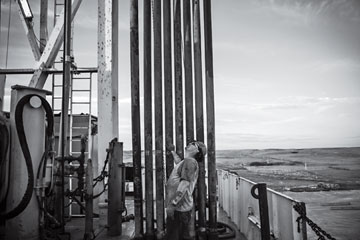
Fracking has unlocked new oil supplies in states like North Dakota, reducing crude imports.
If the American oil and gas industry has a hometown, it's Midland. The West Texas city has been a base for oil companies since drilling in the region first began in the 1920s, and the town has lived and died with the industry in the decades since. Drive the long, flat roads in and out of Midland and you'll see nodding pump jacks, some decades old, pulling oil and gas from the ground. It all comes from the Permian Basin, a hydrocarbon-rich vein of sedimentary rock that has so far produced more than 29 billion barrels of oil. At night, the sparse scrubland is lit up by floodlights from rigs a hundred feet tall and the rig floors buzz with activity, because when times are booming and prices are high, the drilling never stops. Which is exactly why the highways, pipe yards, restaurants and hotels of Midland are so crowded and why you might have better luck renting an apartment in Manhattan than in what Texans call the Tall City.
Through the first six months of 2013, the Permian has been producing nearly 900,000 barrels of oil a day, the highest level in a generation. Unemployment in Midland is at 3.4%. Fast-food restaurants offer bonuses worth $3,000 if employees stay on the job for a few months. That hasn't stopped many of them from seeking the far better wages in the oil and gas fields. The once foundering Petroleum Club in downtown Midland now has a waiting list for membership. And there are proposals to build a 59-story office tower in the heart of the city. "What's happening in the Permian Basin and Texas has been dramatic," says David Porter, head of the Texas railroad commission, which oversees the oil and gas industry. "And what's going on in Texas can be reproduced elsewhere."
It already is. Forty years after the 1973 Middle East oil embargo ushered in an era of energy scarcity, the U.S. is in the midst of a power revolution, driven largely by new technology. Hydraulic fracturing and horizontal drilling have allowed energy companies to unlock vast new supplies of oil and natural gas. Wind and solar have gone from green dreams to economic realities, while utilities are remaking the rickety power grid into something smarter and far less wasteful. Within a decade North America as a whole could produce as much oil as it consumes, reducing the influence of the Middle East. "The transformation we've seen in just the last few years from an outlook of scarcity to one of abundance is real," says Jason Bordoff, director of Columbia University's Center on Global Energy Policy. "It has huge economic, geopolitical and environmental implications."
The benefits are abundant. By displacing dirtier coal, cheap natural gas has helped reduce U.S. greenhouse-gas emissions even as it has boosted U.S. manufacturers that rely on gas as a feedstock. Falling oil imports means that billions of dollars that once went abroad are now staying in the U.S., providing capital for other investments. But energy abundance comes with its own set of challenges. There's already been an environmental backlash against the fevered exploitation of unconventional oil and gas. Nor is there any guarantee that the recent oil boom--which is dependent on high prices--will continue into the future.
